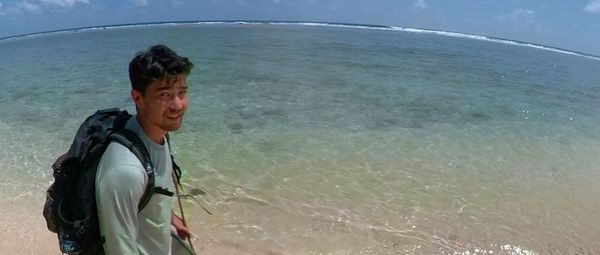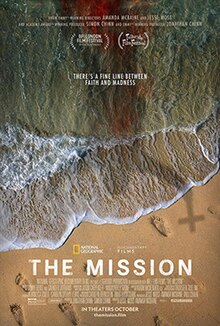Eye For Film >> Movies >> The Mission (2023) Film Review
The Mission
Reviewed by: Andrew Robertson

On November 17th 2018, five years to the day before this film's release, a young man died. What makes The Mission so striking isn't the certainty of that fate but the complexity of the circumstances that brought him to it. Treading a delicate path as it explores his difficult course, the film tries to explore without judgement. In a story where judgement is often lacking, and in a telling where there are a few unusual decisions, this is itself a source of questions, of discomfort, and the better for it.
Amanda McBaine and frequent collaborator Jesse Moss have been producing (in both senses) documentaries for decades. 2014's The Overnighters explored overlapping territories, crises of faith among oil men. They documented another utopian and paean to youth in Boys State. Moss also contributed to 2019's docuseries The Family about the influence of a particular evangelical group on US politics. That quasireligious mindset is vital to The Mission. While there are several other documentaries about individual churches, I'm still looking for a reasonable overview of it all. Films like Jesus Camp , The Armor Of Light and God Loves Uganda all explore the ways that mindset interacts with the rest of the world.
Here the rest of the world is an island, perhaps "Satan's last stronghold." That is 'the rest of the world' in that on that island, North Sentinel near the Anderman archipelago in the Indian Ocean, there exists a tribe who are not in contact with the rest of us. There may be overlaps with the other peoples of the area, the Great Andamanese, the Jarawas, the Nicobarese, the Onge, the Shompen, but the Sentinelese are protected from the outside by decree of the Government of India and, more tellingly, by their own hostility.
There are references to other narratives, others whose deaths in the missionary cause might be martyrdom or mistake. There's talk of survival stories too, though how familiar anyone who's never been to a Scholastic Book Fair will be with Gary Paulsen's Hatchet or its film adaptation I can't say. There's a compelling quote:
"He is no fool, he gives what he cannot keep to gain what he cannot lose."
Whatever conclusion you're drawing from that, you're not alone. The film makes extensive use of John Chau's diaries and his social media posts, voicing them with an actor though he also appears in archive footage much of which he took himself. His father Patrick contributes too: a long letter written to the producers is also voiced by an actor. In one of the film's more discomfiting choices, segments of both are recreated in animation, Jason Carpenter and Holly Davis using an almost watercolour style that creates an impression of distance. There's another choice made with a cut from a GoPro or other action camera that feels exploitative, not least because that transition must be artificial. John's body has not been recovered.
Even knowing the outcome there are plenty of revelations. Indeed the film makes a habit of concealing and revealing things that force reevaluations from new contexts. Some of these are themselves underexplored, but those being interviewed seem both open and honest about their actions, if not necessarily their involvement. Adam Goodheart's concern about his own responsibility is touching, while the corporatist managerialism of another group talking about "screening for the messiah complex" is chilling.
There are some wild dissonances within the tale. Perky Jerky sits uneasily with the devastation of nine-tenths of a beloved landscape. Discussions of radicalisation and medical school clasp hands with terms like 'part of the spear' and 'safe house'. When someone says "there's a certain point where the plane cannot avoid the mountain," there's so much to unpick in its fatalism that one starts to go back and forth about every word everyone uses.
That includes nicknames. John worked for a time in a place where everyone had alliterative addenda. His was 'jackalope'. That's a cryptid, a hoax of sorts. It might have roots in the appearance of rabbits with horns as a result of viral infection, but much like the revival of revivalism it's really a product of the commerce and culture of the 20th Century United States. The horned hare, half jackrabbit, half antelope is itself a thing of hybridity, and popularised as a taxidermic novelty, its attention is post-mortem.
The film doesn't explore this. It doesn't explore lots of things, because as indicative as John's story is, there's barely room in nearly two hours to cover much beyond the basics. That it does well, but with some decisions that I'm still uneasy about. There are four sets of people here: those who saw him on his way, the child who became the young man, those who saw him at his end, and those telling the story. Two of them cannot speak now, inaccessible across the ocean or the Styx. Two of them have others to speak for them if they cannot do so themselves. Two of them make choices in their telling where what is unspoken can say as much as what is voiced.
My rule of thumb for documentary is that the best have an interesting subject covered in an interesting way. You can manage with one or the other, true, but both sides make a story. Due to its choices because some of those sides are unavailable The Mission becomes itself difficult, but is the stronger for it. The certainties of belief, of grief, are palpable, but what is most striking about a story of a fateful visit to an untouched corner of the world is the stations along the way. Where The Mission falters perhaps is that the scale and scope of its story is larger than it seems. On that fatal shore two worlds came together, but this hasn't map enough for both.
Reviewed on: 17 Nov 2023

















